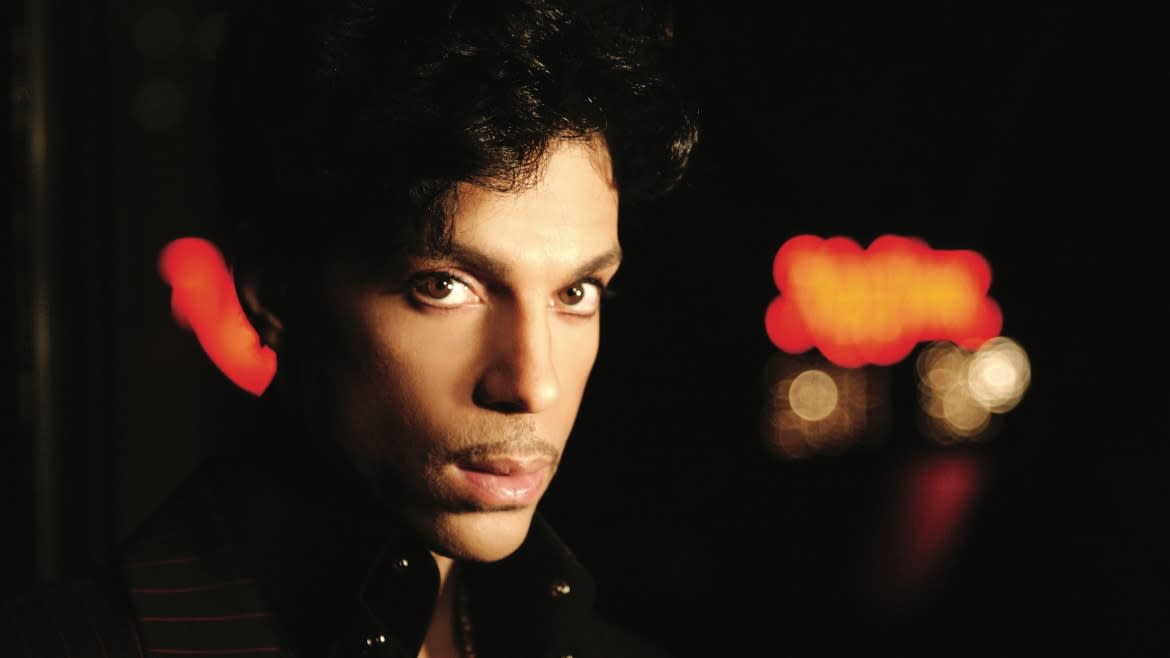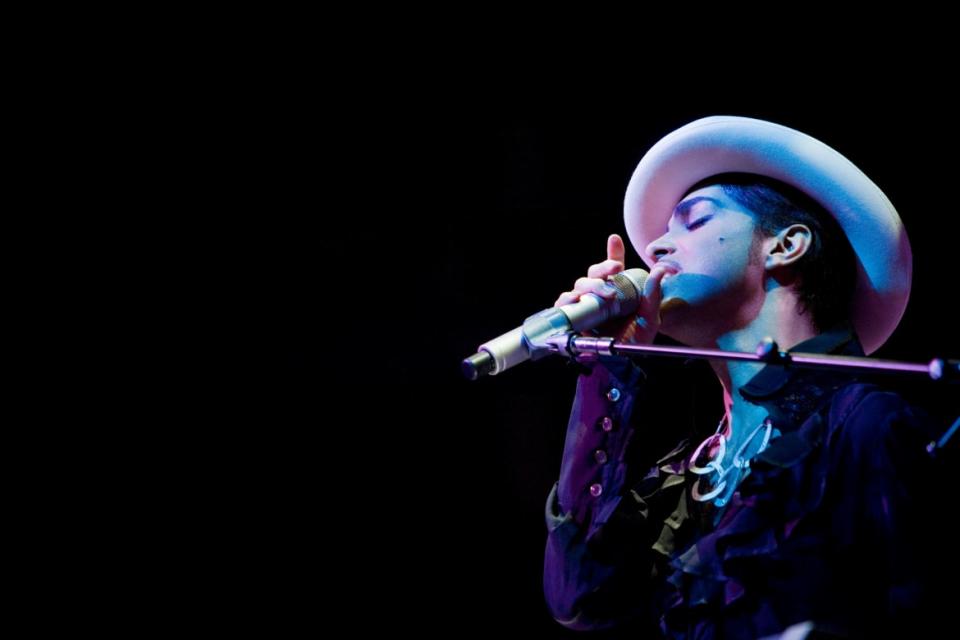How Anger Fueled Prince’s Masterful ‘Musicology’

When Prince released his 28th studio album, Musicology, in 2004, it was hailed as a remarkable return to form. Though he’d released a steady stream of music throughout the 1990s and early 2000s, most of those albums were deemed too conceptual or uncommercial. But Musicology—which turns 20 years old on April 20, just one day shy of the eighth anniversary of Prince’s death—is perhaps the high-water mark of that period. An old-school funk record made with virtuoso musicians playing real instruments—which even at the time was a novelty—it featured heaps of what Prince was best at, including infectious, R&B-tinged pop songs, dance workouts, slow jams, and even political rants delivered with a swagger he’d not exhibited since his mid-’80s heyday.
Of course, being a genius can be a fraught road. With albums like 1999, Purple Rain, and Sign ‘O’ the Times, Prince had set a bar so high that, by 2004, after more than a decade of fighting with his record label, writing “SLAVE” across his face, and changing his name to an unpronounceable symbol, many fans had moved on and were satisfied with simply revisiting his greatest hits whenever they came on the radio.
Then came Musicology. And while it wasn’t Prince redefining the music landscape the way he did in the ’80s, upon its release, fans reveled in its breezy confidence and in, once again, hearing every facet of his genius.
“This record… remember, it’s made by someone who’s been there and back,” Prince said at the time of evoking the great funk records of the ’70s. “Hopefully people feel that and listen to it with that set of ears. Music is music, ultimately. If it makes you feel good? Cool.”
It certainly resonated. Musicology went top five around the world and spawned hits like “Call My Name” and “Cinnamon Girl.” But Alan Light, author of the ultimate book on the legend’s golden period, Let’s Go Crazy: Prince and the Making of Purple Rain, believes that, by 2004, with Prince’s finger firmly on the zeitgeist, it was nothing more than flipping a switch for the Purple One.
“Musicology was an active decision to say, ‘OK, these are the switches I need to hit to go be a creative force in the world,’” Light says. “‘I know what they are. I’ll show you what that is.’”
Sometimes, that came at a cost—but one that Prince was willing to pay, says drummer Michael Bland, who was a member of Prince’s New Power Generation.

“Prince was like David Bowie in that he thought, I’ll give my audience a little bit of what they want, but I’m mostly going to do what I want,” Bland says. “He certainly wasn’t afraid to lose fans, if it meant going where he needed to go. In fact, quite the opposite. If the fans he’d gained didn’t get where he was going, he was happy to leave them behind.”
Still, if recent archival releases are any indication, in much the same way Bob Dylan fans scratch their heads at how he often leaves some of his best tracks off his album releases, Prince often held back amazing material. “United States Of Division,” a Musicology-era B-side, was recently released to streaming services in celebration of the album’s anniversary. The powerful protest song sees Prince lamenting the state of a fractured nation: “How far from heaven must we go? / Before the winds of change will blow and show / This world how it’s supposed to be / Land of peace and harmony.”
Written and recorded at the height of the war in Iraq, “United States Of Division” serves as a potent reminder of Prince’s often under-appreciated passion for social commentary, as well as his ability to write a timeless song, no matter the subject matter. Because while Prince’s lyrics may be referring to a moment 20 years ago, his unyielding stance on inequality remains just as relevant in today’s turbulent socio-political landscape.
“It’s obvious that there’s an agenda against the disenfranchised and the uneducated,” Prince said at the time. “So ultimately, I think, to counter that, we’re gonna have to talk to one another. One of the ways we used to do that was through our music.”
As for where Musicology now sits in Prince’s canon, while it was considered a return to form at the time, Light feels it holds up to the artist’s best work.
“On Musicology, first of all, you feel him working on the songwriting again,” Light says. “You feel very explicit self-editing going on, but there’s also this additional layer of effort going on in those records. And there’s this re-embrace of old-school R&B, and then the stripped-down sound. Remember, we were now post-Napster, and however many years into hip hop’s explosion, coming out of the Bad Boy and Death Row era, and the pop takeover by Britney and NSYNC. And here he was saying, I want to celebrate musicianship and traditional, quality songwriting. For any fan, at the time, it was amazing. But today, those are albums worth everyone’s time and attention, because they are that good.”
“If you can see the finish line before you start the race, that’s a true artist,” Bland says of his former mentor. “Prince’s greatest gift was his inspiration and his creativity, because it’s not that he was a great guitar player, for instance. It’s what he was able to say with it.”
In the aftermath of Musicology’s release, Prince seemed to be everywhere. The album earned him two Grammy Awards at the 2005 ceremony—where he memorably duetted with Beyoncé—and was certified double platinum that same year. The Musicology tour, meanwhile, became Prince’s highest-grossing U.S. tour, with him and his band performing to over 1.4 million fans. The album came at the peak of his 2000s resurgence, coinciding neatly with his induction into the Rock & Roll Hall Of Fame, where he famously performed a stirring guitar solo on an all-star rendition of The Beatles’ classic “While My Guitar Gently Weeps” to mark George Harrison’s induction into the Rock Hall.
“They gave away Musicology with tickets to the tour—something he’d always resisted in the past, branding a tour to an album—and there was the Rock & Roll Hall of Fame induction and the Grammy performance. That all led to the Super Bowl performance in 2006,” Light recalls, marveling at how effortless it all seemed for an artist who had been through so many ups and downs since becoming part of the cultural firmament with Purple Rain.
“I think that so much of the story of his entire career is this tension between some very big questions,” Light notes. “Is he a huge pop star or is he the world’s biggest cult artist? Is he somebody who goes out and fills stadiums, or is he somebody who has a million people who are on for the ride and it can go wherever he wants? And, you know, he could turn up or down those dials. And because of that tension between those two sides, you’re never sure if he’s over-performing or under-performing. Unfortunately, too much of the time, he wanted both of those things.”
Perhaps it was that desire that informed what Reggie Griffith, Prince’s sometime front-of-house sound engineer, describes as the artist’s “astonishing” work ethic during that time in his career.
“We would get a text and we would have to go to Paisley Park,” Griffith recalls. “Let’s say that was at two in the afternoon. So we’d all show up and we’d go to work from, say, two to ten. Then he’d open up Paisley Park and he’d do a show for two or three hours, sometimes with a special guest. Then he’d take that special guest, after the show, and they’d go into Studio A and they’d work on songs till eight in the morning. And then we would get another text to come in, same thing, two o’clock, the next day, and we would do it all again. And that might go on for something like 20 days straight. It was relentless. I remember thinking, ‘Fuck. This is making me good!’”
Ultimately, the period covered by Musicology and its excellent follow-up, 3121, was one of artistic ups and downs, of triumphs and failures. After fighting for his artistic freedom for years in the wake of Purple Rain’s success, it may have taken what seemed like ages for Prince to find his footing. But once he did, he asserted himself as the best in the business—while never losing grip of the thing that drove him: his deep love of music.
“It was never turned off. He was never not Prince,” Light recalls. “But when you would sit down, he would want to talk about old Earth, Wind & Fire records, or whatever you were listening to, or what he was listening to, because he was a fan, always. Even from fairly early on, dealing with him didn’t feel like you were dealing with a regular, average guy. It didn’t feel like he was issuing pronouncements when he talked, as some artists do. He was funny and shy, of course, but then he would get going on music, and you couldn’t stop him. And you can feel that in these albums here, for sure.”
“As he became discontented with his artistic situation, he changed as a person,” Bland remembers of his former boss and the Musicology era. “But if anything, it drove him. He worked harder, as though he had something to prove, even if that was only to himself. Anger is just another emotion for you to make what you want to happen in your life, and I feel like Prince used that to drive himself.”
We’re Still Wrestling With What Prince Taught Us About Sex
Get the Daily Beast's biggest scoops and scandals delivered right to your inbox. Sign up now.
Stay informed and gain unlimited access to the Daily Beast's unmatched reporting. Subscribe now.

